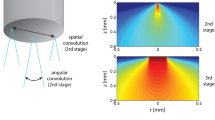We have developed a computational platform that simulates light transport in tissue in support of biomedical optics research. Although in its initial stage of development, this platform is being used to answer important questions regarding the detection of tissue changes, and the optimal design and positioning of optical probes to ‘interrogate’ the tissue best. We provide answers to such questions by applying perturbation and midway surface Monte Carlo techniques. Derivation of these methods makes rigorous use of the radiative transport equation which is essential if the methods are to provide accurate solutions for highly complex media such as biological tissue.
Access this chapter
Tax calculation will be finalised at checkout
Purchases are for personal use only
Preview
Unable to display preview. Download preview PDF.
Similar content being viewed by others
References
D. A. Boas, M. A. O’Leary, B. Chance, and A. G. Yodh. Detection and characterization of optical inhomogeneities with diffuse photon density waves: a signal-to-noise analysis. Appl. Opt., 36(1):75–92, 1997.
S. K. Chang, D. Arifler, R. Drezek, M. Follen, and R. Richards-Kortum. Analytical model to describe fluorescence spectra or normal and preneoplastic epithelial tissue: comparison with Monte Carlo simulations and clinical measurements. J. Biomed. Opt., 9(3):511–522, 2004.
T. Collier, D. Arifler, A. Malpica, M. Follen, and R. Richards-Kortum. Determination of epithelial tissue scattering coefficient using confocal microscopy. IEEE J. Sel. Top. Quantum Electron., 9(1):307–313, 2003.
T. Collier, M. Follen, A. Malpica, and R. Richards-Kortum. Sources of scattering in cervical tissue: determination of the scattering coefficient by confocal microscopy. Appl. Opt., 44(11):2071–2081, 2005.
S. N. Cramer. Forward-adjoint Monte Carlo coupling with no statistical error propagation. Nucl. Sci. Eng., 124:398–416, 1996.
H. Fang, M. Ollero, E. Vitkin, L. M. Kimerer, P. B. Cipolloni, M. M. Zaman, S. D. Freedman, I. J. Bigio, I. Itzkan, E. B. Hanlon, and L. T. Perelman. Noninvasive sizing of subcellular organelles with light scattering spectroscopy. IEEE J. Sel. Topics Quantum Elec., 9(2):267–276, 2003.
S. Feng, F. Zeng, and B. Chance. Photon migration in the presence of a single defect: a perturbation analysis. Appl. Opt., 34(19):3826–3837, 1995.
C. K. Hayakawa. Perturbation Monte Carlo Methods for the Solution of Inverse Problems. PhD thesis, Claremont Graduate University, 2002.
C. K. Hayakawa and J. Spanier. Perturbation Monte Carlo methods for the solution of inverse problems. In Monte Carlo and Quasi-Monte Carlo Methods 2002, pages 227–241. Springer, 2004.
C. K. Hayakawa, J. Spanier, F. Bevilacqua, A. K. Dunn, J. S. You, B. J. Tromberg, and V. Venugopalan. Perturbation Monte Carlo methods to solve inverse photon migration problems in heterogeneous tissues. Opt. Lett., 26(17):1335–1337, 2001.
C. K. Hayakawa, J. Spanier, and V. Venugopalan. Coupled forward-adjoint monte carlo simulations of radiative transport for the study of optical probe design in heterogeneous tissues. SIAM J. on Appl. Math., accepted.
Y. L. Kim, R. K. Wali, H. K. Roy, M. J. Goldberg, A. K. Kromin, K. Chen, and V. Backman. Simultaneous measurement of angular and spectral properties of light scattering for characterization of tissue microarchitecture and its alteration in early precancer. IEEE J. Sel. Topics Quantum Elec., 9(2):243–256, 2003.
C. J. Mann, L. Yu, C.-M. Lo, and M. K. Kim. High-resolution quantitative phase-constrast microscopy by digital holography. Opt. Exp., 13 (22):8693–8698, 2005.
M. S. Patterson, S. Andersson-Engels, B. C. Wilson, and E. K. Osei. Absorption spectroscopy in tissue-simulating materials: a theoretical and experimental study of photon paths. Appl. Opt., 34(1):22–30, 1995.
J. Spanier and E. Gelbard. Monte Carlo Principles and Neutron Transport Problems. Addison-Wesley, 1969.
J. C. Schotland, J. C. Haselgrove, and J. S. Leigh. Photon hitting density. Appl. Opt., 32(4):448–453, 1993.
I. V. Serov, T. M. John, and J. E. Hoogenboom. A new effective Monte Carlo midway coupling method in MCNP applied to a well logging problem. Appl. Radiat. Isot., 49(12):1737–1744, 1998.
I. V. Serov, T. M. John, and J. E. Hoogenboom. A midway forward-adjoint coupling method for neutron and photon Monte Carlo transport. Nucl. Sci. Eng., 133:55–72, 1999.
I. Seo, J. S. You, C. K. Hayakawa, and V. Venugopalan. Perturbation and differential Monte Carlo methods for measurement of optical properties in a layered epithelial tissue model. J. Biomed. Opt., 12(1):014030, 2007.
T. Ueki and J. E. Hoogenboom. Exact Monte Carlo perturbation analysis by forward-adjoint coupling in radiation transport calculations. J. Comput. Phys., 171:509–533, 2001.
T. Ueki, J. E. Hoogenboom, and J. L. Kloosterman. Analysis of correlated coupling of Monte Carlo forward and adjoint histories. Nucl. Sci. Eng., 137:117–145, 2001.
M. L. Williams and W. W. Engle. The concept of spatial channel theory applied to reactor shielding analysis. Nucl. Sci. Eng., 62:92–104, 1977.
M. L. Williams. Generalized contributon response theory. Nucl. Sci. Eng., 108:355–383, 1991.
Author information
Authors and Affiliations
Editor information
Editors and Affiliations
Rights and permissions
Copyright information
© 2008 Springer-Verlag Berlin Heidelberg
About this paper
Cite this paper
Hayakawa, C., Spanier, J., Venugopalan, V. (2008). Computational Engine for a Virtual Tissue Simulator. In: Keller, A., Heinrich, S., Niederreiter, H. (eds) Monte Carlo and Quasi-Monte Carlo Methods 2006. Springer, Berlin, Heidelberg. https://doi.org/10.1007/978-3-540-74496-2_25
Download citation
DOI: https://doi.org/10.1007/978-3-540-74496-2_25
Publisher Name: Springer, Berlin, Heidelberg
Print ISBN: 978-3-540-74495-5
Online ISBN: 978-3-540-74496-2
eBook Packages: Mathematics and StatisticsMathematics and Statistics (R0)




